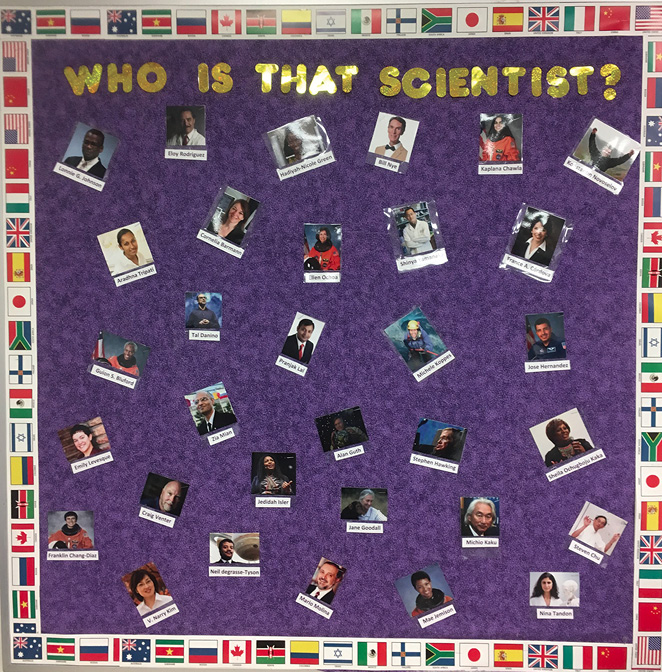commentary
Science Identity Matters
Science Scope—March/April 2022 (Volume 45, Issue 4)
By Helen Brandon
I remember in my early years of science teaching, I assigned my students the same assignment I had once completed as a student—I asked my students to draw a scientist (Chambers 1983). As the students compared and contrasted their drawings and then came to group consensuses, I saw the same drawings that had emerged when I was a youth. The drawings looked like Albert Einstein, resembling a white man with crazy hair and a white lab coat. This activity is one that science educators often use to lead into a deeper discussion about scientists and the students’ own biases and misconceptions of who scientists are and are not. However, educators often follow this meaningful discussion by jumping straight into curriculum and do not always connect back to this opening identity activity. It is our obligation to go beyond the activity and layer in identity development, particularly during a student’s middle years.
NGSS call for science for all
As stated in Appendix D of the Next Generation Science Standards (NGSS) Framework, “the NGSS are intended to provide a foundation for all students, including those who can and should surpass the NGSS performance expectations” (NGSS Lead States 2013). Furthermore, the case studies in Appendix D place an emphasis on our nation’s changing demographics and challenge us to create better learning opportunities for all student groups.
Why identity must be a focus in the middle years
Multiple studies have emerged that have connected the development of a science identity to a greater pursuit of science careers and fields (Carlone and Johnson 2007; Kim, Sinatra, and Seyranian 2018). However, the individuals who pursue STEM careers are not representative of our changing demographics. Furthermore, we lose many students in the middle years who choose to disengage within the science classroom.
Focusing on identity is necessary to understand a youth’s perception about his/her/their/ self, science, and the work of scientists (Kang et al. 2019; Kim, Sinatra, and Seyranian 2018). Additionally, students’ engagement and academic achievement is negatively affected when they do not identify with the science classroom (Gholson and Wilkes 2017). For example, although many students of color find success in the classroom, many do not identify with STEM fields and do not feel recognized for their own contributions to the classroom (Archer et al. 2013). Multiple efforts have been undertaken to create opportunities outside of the classroom through clubs, activities, and so forth that target females and students of color, but to achieve science for all as outlined by the NGSS, we must intentionally focus on science identity development within the classroom.
Funds of knowledge
One approach to creating spaces that embrace identity is by using a funds of knowledge approach. The funds of knowledge approach is built on the premise and understanding that people have knowledge and are competent as a result of their life experiences and family backgrounds (González, Moll, and Amanti 2005). Tapping into a student’s funds of knowledge by developing spaces driven by phenomena that are culturally relevant can create opportunities for science educators to listen to their students. Furthermore, by creating driving question boards in which students create the questions that they get to investigate, students can connect to their own experiences and see their funds of knowledge as tools that are connected to the science classroom and to the phenomena they are exploring—thus building their science identities.
How do we begin?
Consider what you are already doing and think about how you can use student voice and space to layer identities into the science classroom. Let’s begin with the original opening activity. Try taking the activity to the next level by giving students the time to research scientists from diverse backgrounds, which will help the students see themselves as scientists. Have the students explore the vast career opportunities in science, draw self-portraits in one of these careers, and write about the career. Use the poster examples done by Nevertheless Podcasts (see Online Resources) to explore different individuals in STEM; these STEM role model images are available in eight languages. Intentionally layer in identity development into every unit by engaging with phenomena that connect with your students’ backgrounds, languages, and experiences. For example, when studying climate change, explore the effects a changing climate has on other countries and explore the actions of other countries in minimizing their human footprint. An example of this would be the usage of avocado straws instead of plastic ones in Mexico, while Mexican homes utilize black water cisterns on roofs for harvesting solar energy, which is used to heat water for bathing.
Examine your learning space with a critical eye; whose identity is affirmed in your space? Take the time to create a space for driving question boards, intentionally include pictures that represent the diversity in science, and be linguistically inclusive. This can be done by having posters and pictures that represent scientists of diverse backgrounds, having science posters and vocabulary represented in multiple languages, and having areas where students see themselves as scientists by hanging student work in your classroom.Finally, learn about and listen to your students through meaningful discourse about diverse and engaging phenomena. By giving space for student talk and creating an intentionally inclusive classroom space, you provide an environment that encourages science identity development and move closer to a model that allows students to internalize that science is truly for all. •

Online Resources
Nevertheless STEM role models posters—https://bit.ly/3ojVZZi
Dr. Helen Brandon (helenbrandon02@gmail.com; Twitter @HelenDBrandon) is a middle school bilingual math and science teacher at Bloomington Junior High School in Bloomington, Illinois and an adjunct professor at Illinois State University in Normal.
Equity Inclusion Interdisciplinary Pedagogy Middle School


